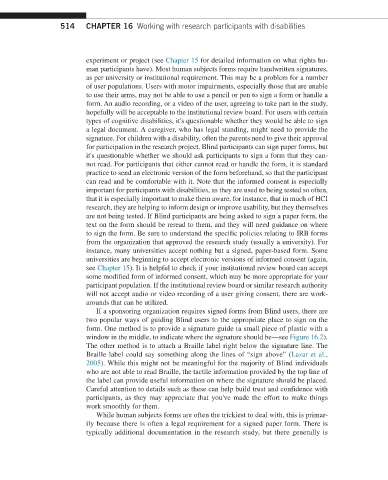Page 521 -
P. 521
514 CHAPTER 16 Working with research participants with disabilities
experiment or project (see Chapter 15 for detailed information on what rights hu-
man participants have). Most human subjects forms require handwritten signatures,
as per university or institutional requirement. This may be a problem for a number
of user populations. Users with motor impairments, especially those that are unable
to use their arms, may not be able to use a pencil or pen to sign a form or handle a
form. An audio recording, or a video of the user, agreeing to take part in the study,
hopefully will be acceptable to the institutional review board. For users with certain
types of cognitive disabilities, it's questionable whether they would be able to sign
a legal document. A caregiver, who has legal standing, might need to provide the
signature. For children with a disability, often the parents need to give their approval
for participation in the research project. Blind participants can sign paper forms, but
it's questionable whether we should ask participants to sign a form that they can-
not read. For participants that either cannot read or handle the form, it is standard
practice to send an electronic version of the form beforehand, so that the participant
can read and be comfortable with it. Note that the informed consent is especially
important for participants with disabilities, as they are used to being tested so often,
that it is especially important to make them aware, for instance, that in much of HCI
research, they are helping to inform design or improve usability, but they themselves
are not being tested. If Blind participants are being asked to sign a paper form, the
text on the form should be reread to them, and they will need guidance on where
to sign the form. Be sure to understand the specific policies relating to IRB forms
from the organization that approved the research study (usually a university). For
instance, many universities accept nothing but a signed, paper-based form. Some
universities are beginning to accept electronic versions of informed consent (again,
see Chapter 15). It is helpful to check if your institutional review board can accept
some modified form of informed consent, which may be more appropriate for your
participant population. If the institutional review board or similar research authority
will not accept audio or video recording of a user giving consent, there are work-
arounds that can be utilized.
If a sponsoring organization requires signed forms from Blind users, there are
two popular ways of guiding Blind users to the appropriate place to sign on the
form. One method is to provide a signature guide (a small piece of plastic with a
window in the middle, to indicate where the signature should be—see Figure 16.2).
The other method is to attach a Braille label right below the signature line. The
Braille label could say something along the lines of “sign above” (Lazar et al.,
2005). While this might not be meaningful for the majority of Blind individuals
who are not able to read Braille, the tactile information provided by the top line of
the label can provide useful information on where the signature should be placed.
Careful attention to details such as these can help build trust and confidence with
participants, as they may appreciate that you've made the effort to make things
work smoothly for them.
While human subjects forms are often the trickiest to deal with, this is primar-
ily because there is often a legal requirement for a signed paper form. There is
typically additional documentation in the research study, but there generally is

